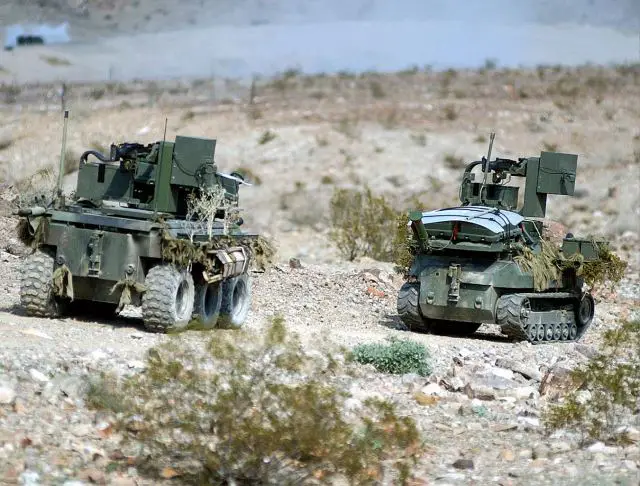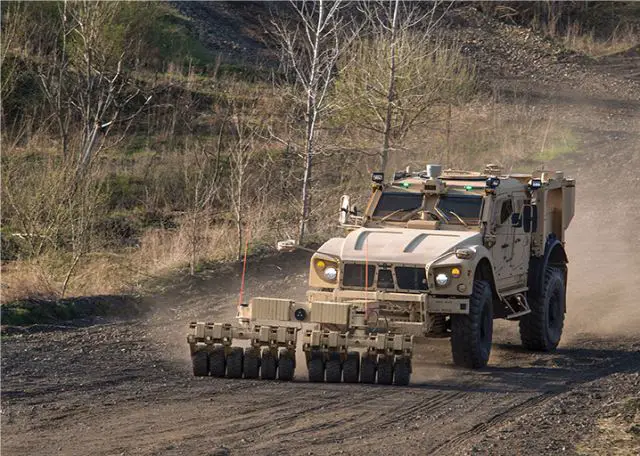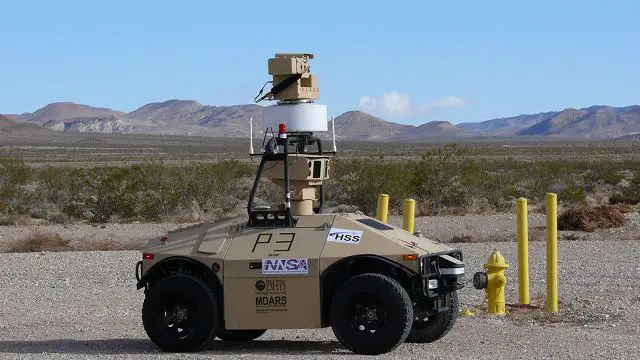|
|
|||
|
Military defense industry Technology - Autonomous tactical vehicle
|
|||
|
|
|||
| United States Army is working to develop a full autonomous tactical vehicle. | |||
|
The U.S. Army is working toward developing a fully autonomous tactical vehicle, a robotics expert said. Autonomous vehicles will be able to operate without direct human supervision and are a step up from unmanned vehicles, which are typically controlled remotely. Today, unmanned aerial systems, for instance, have remote operators. In contrast, autonomous vehicles would be operated robotically.
|
|||
|
|
|||
 Tracked and wheeled versions of the Gladiator Tactical Unmanned Ground Vehicles (TUGV) take a forward position to determine security of the area. Tracked and wheeled versions of the Gladiator Tactical Unmanned Ground Vehicles (TUGV) take a forward position to determine security of the area. |
|||
|
|
|||
|
"When you start looking at the mid-term, five to 10 years, we start talking about tapping into external systems," said Mark Mazzara, robotics interoperability lead for the Army's Program Executive Office - Combat Support and Combat Service Support at Detroit Arsenal, Michigan.
Mazzara was a panelist, April 8, at the National Defense Industrial Association Ground Robotics Capabilities Conference and Exhibition in Crystal City, Virginia, where he discussed the path toward autonomous capabilities. Mazzara explained that is followed by basic autonomy capabilities, which then lay the foundation for the third phase, a fully autonomous tactical vehicle. The Army wants its Unmanned Ground Vehicle Interoperability Profile, or IOP, to enable this "evolutionary approach toward tactical vehicle autonomy," he said. "In the far term, we start talking about more ubiquitous interoperability between the robots and external systems," Mazzara said. Today, semi-autonomous systems are used to clear mines, provide surveillance, convoy supplies and acquire targets, among many other things. To reach autonomous capability, the Army needs incremental hardware and software enhancements to existing systems/chassis; sensor and payload upgrades; modularity; open architecture in IOP, or, in- and out-processing software; standardization; miniaturization and light weight; and, intelligent behavior. One conference attendee said the problems of developing a fully autonomous vehicle were complex and it might take 30 years. Another conference panelist predicted that in possibly 10 years, the Army might have a rudimentary system that could recognize markings or patterns, especially in open terrain, to operate autonomously. To reach that point, Mazzara recommended coordination with stakeholders, keeping industry informed and stressing the value of IOP development. The profile would benefit everyone in the defense community, he said. |
|||
|
|
|||
 Oshkosh Defense M-ATV with Terramax unmanned ground vehicle technology. Oshkosh Defense M-ATV with Terramax unmanned ground vehicle technology. |
|||
|
|
|||
|
Many U.S. Companies were started the development of unmanned ground vehicle as Aoshkosh Defense with Terramax.
Designed for use on any tactical wheeled vehicle and backed by thousands of miles of field testing, the Oshkosh TerraMax UGV is capable of supervised autonomous navigation in either a lead or follow role. Its multi-sensor system combines with novel registration techniques to provide accurate positioning estimates without needing to rely on continuous tracking through a lead vehicle or GPS signals. When equipped with the Oshkosh TerraMax UGV, each vehicle is capable of navigation to the objective independently. This not only facilitates tight convoy formation, but also enables the composition of the convoy to change as demanded by traffic conditions, road blockages or other obstructive situations. |
|||
|
|
|||
 General Dynamics Robotic Systems MDARS (Mobile Detection Assessment and Response System). General Dynamics Robotic Systems MDARS (Mobile Detection Assessment and Response System). |
|||
|
|
|||
|
General Dynamics Robotic Systems has also a project of unmanned ground combat vehicle which is called MDARS (Mobile Detection Assessment and Response System).
MDARS, a program of the Army’s JPEO-CBD – PM Force Protection Systems, is a small and nimble robotic patrol force on wheels designed to relieve personnel of the repetitive and sometimes dangerous task of patrolling exterior areas that require some level of security. General Dynamics Robotic Systems (GDRS) has been developing the MDARS concept since 1993. The MDARS robot is designed to perform random patrols around Department of Defense warehouses, airfields, ammunition supply depots, and port facilities. It detects intruders and determines the status of inventory, barriers, and locks. |
|||
United States Army is working to develop a full autonomous tactical vehicle.
- Posted On














